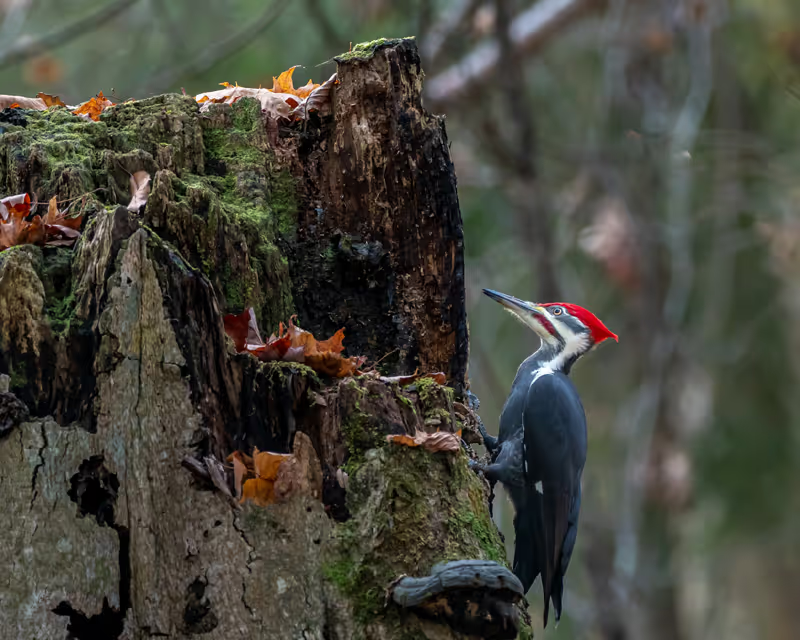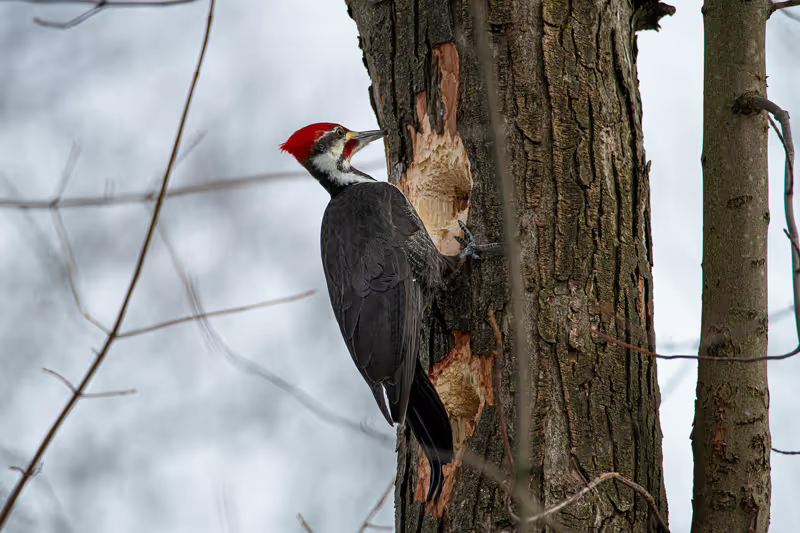Loud and Mighty: Getting to Know the Pileated Woodpecker


About the size of a crow, the pileated woodpecker is the largest woodpecker in North America. Males are recognizable from their bright red tufted “cap” and red and white markings along both sides of their face. Females look similar to males, with a yellowish-brown patch in front of their red crest and without the red “mustache” markings. When in flight, pileated woodpeckers can be identified by their large black wings with white “moons” on the underside of each wing. The easiest way to identify a pileated woodpecker, though, is by its loud and chattering call.
The pileated woodpecker’s bright red crest and high-pitched, some may say maniacal, call are said to have inspired cartoonist Walter Lantz’s most famous creation, Woody the Woodpecker. (There is some controversy behind this claim, though. Lantz himself reported to have taken inspiration from the acorn woodpecker. Many birders disagree. You can decide for yourself; compare the call of a pileated woodpecker with that of an acorn woodpecker, and then listen to Woody. Woody sounds like a pileated woodpecker to me.)
While pileated woodpeckers usually remain out of sight, their loud, alarm-like call and drum-like drilling can often be heard throughout our coastal forests. The pileated woodpecker is a resilient species that has adapted well to living near humans, preferring moist, wooded habitats—ideally old growth or second growth forests. They have a relatively long lifespan of 12 years.
With pairs mating for life, pileated woodpecker “courtship” begins in the early spring—you will likely hear even more of the trademark drumming around this time of the year. During breeding and nesting periods from March to July, pileated woodpeckers may begin many different cavity excavations, but usually complete just one nest cavity for the season.

Pileated woodpeckers chip out characteristically large oval and rectangular shaped excavations, sometimes tearing apart stumps and large sections of logs—they have even been known to bring down trees!
Up to 60% of a pileated woodpecker’s diet is made up of carpenter ants, but it will also consume beetle larvae, other insects, fruit, and nuts. Pileated woodpeckers have a “special appetite” for the carpenter ants that live in decayed heartwood of living trees.
Although a pileated woodpecker is a relatively rare sight in Western Washington, it is considered to be a keystone species in our forests. This means the forests that pileated woodpeckers inhabit would be “dramatically different” without them—or “may cease to exist altogether.” Other keystone species in this region include beaver, sea otter, and chinook salmon.
One reason that the pileated woodpecker is such an influential species in the forests of the Pacific Northwest is because it is the only woodpecker in this region that can gouge into hard, healthy wood. By exposing trees to heart-rot fungi, pileated woodpeckers support the decay and nutrient-cycling processes of a healthy forest. They also help provide easier foraging and nesting access for other species, like tree-dwelling ducks, bats, owls, squirrels, and other species. Large cavity nesters like fishers (large weasels) especially depend on the excavating work of pileated woodpeckers.
The pileated woodpecker is a “primary excavator,” which means it creates its own roosting and nesting cavities. Due to their size, pileated woodpeckers choose large snags or living trees, selecting based on diameter, height, and state of decay. Pileated woodpecker pairs share territory, but roost separately, often with individual cavities within the same tree. Nesting sites tend to be 15 to 70 feet up on dead or dying trees. Entrance holes to the nest are about 3.5 inches in diameter. The nest cavity, which pileated pairs line with with beak-fulls of wood chips, runs between 10 and 24 inches deep. Pileated woodpeckers rarely return to the same nest site year after year, so once abandoned, these sound and roomy cavities make prime shelters for a variety of forest life.
While the pileated woodpecker is among 11 known species of woodpecker in Washington State, its nests are both larger and have more “structural integrity" than those of other woodpeckers. At least 20 different species of “secondary cavity dwellers” have been recorded using old cavities excavated by a pileated woodpecker.
Sources:
Photo 1 by Patrice Bouchard on Unsplash
Photo 2 by Jason Gillman on Pixabay
Hetzler, Paul J. “Woodpeckers are Beneficial,” Cornell Forest Connect: http://cornellforestconnect.ning.com/profiles/blogs/woodpeckers-are-beneficial?overrideMobileRedirect=1. Accessed 15 May 2022.
“Pileated Woodpecker: Dryocopus Pileatus.” Audubon Society: https://www.audubon.org/field-guide/bird/pileated-woodpecker. Accessed 15 May 2022.
“Pileated Woodpecker Habits.” Wild Bird Watching: https://www.wild-bird-watching.com/Pileated_Woodpecker.html. Accessed 15 May 2022.
“Pileated Woodpecker.” National Parks Service: https://www.nps.gov/articles/pileated-woodpecker.htm. Accessed 15 May 2022.
“Pileated Woodpecker (Dryocopus Pileatus).” Washington State Department of Fish and Wildlife: https://wdfw.wa.gov/species-habitats/species/dryocopus-pileatus#desc-range. Accessed 15 May 2022.
“Role of Keystone Species in an Ecosystem.” National Geographic: https://www.nationalgeographic.org/article/role-keystone-species-ecosystem/. Accessed 15 May 2022.
U.S. Department of Agriculture Pacific Northwest Research Station. “Coming Home to Roost: The Pileated Woodpecker as Ecosystem Engineer.” Science Findings: http://www.greenbeltconsulting.com/assets/pdfs/ComingHomeToRoost.pdf. Accessed 15 May 2022.
© Holly Duffy, May 2022
Touch whale bones, examine shipwreck artifacts and connect with the coast's living history.

Support our mission, get involved in educational programs, or contribute through donations and volunteering.